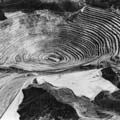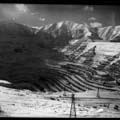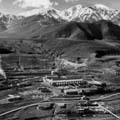You are here
Bingham Canyon Open Pit Copper Mine
The Bingham Canyon Mine is one of the largest man-made excavations on earth, visible from outer space. In 2013, it reached a width of 2.5 miles and a depth of 3,900 feet. An active mine, its steady growth is a product of the mining industry that has been a major player in Utah’s economy since the 1860s. Before this period, the Church of Jesus Christ of Latter-day Saints (LDS Church), which had a major say in the development of the area, discouraged mining of precious metals for fear it would take valuable manpower away from agriculture and attract non-Mormon settlers. But by the late 1860s mining was driving the economy of the region and the LDS Church did not see it prudent to remain behind. The completion of the transcontinental railroad in 1869 gave Utah access to international markets and mining activity increased accordingly. Copper, uranium, silver, and iron have all been mined in the state.
This mining venture, however, was connected to out-of-state prospectors and venture capitalists—not the LDS Church. The Utah Copper Company, under founding owners Enos Andrew Wall, a regional mining prospector from Indiana, and metallurgist Daniel C. Jacking from Missouri, solicited investments from mining magnates Spencer Penrose and Charles L. Tutt Sr., both of Philadelphia. With additional funding from the Guggenheims, exploration started in 1906 with a pilot mill at Copperton, the north end of the copper mine. In 1915, with the mine considerably expanded, the company was restructured as the Kennecott Copper Corporation. World War II brought a major boom in mining activities, and the mine made a mark on the global metal industry. It produced about 30 percent of all the copper used by the Allied Forces for weapons, equipment, tools, and communication wires.
The mine is at once an astonishing feat of engineering and a menace to the environment. Progressive excavation has given the mine the form of a terraced pit, reminiscent of rice or tea paddies but, of course, with none of the life-sustaining soil, greenery, and crops. Standing at the edge of the pit and gazing upon the innumerable layers of multi-hued rock, patiently revealed in the course of more than a century of daily labor, is a sublime experience. Its scale is difficult to grasp; eighteen-foot-tall mining vehicles are barely discernible at the bottom of the pit. The terraced form is meant to avoid land erosion and maintain the stability of the engineered topography. But on April 10, 2013, two landslides occurred in rapid succession that displaced about 65 million cubic meters of rock on the northeastern wall. Seismographs predicted the slides, giving miners time to evacuate.
This sublime earthwork comes at a high environmental price. Since its very origin, sulfur dioxide emissions from the smelters have been blamed for destroying the yield of neighboring farms. In 1912, environmentalists pointed to the health effects of the high level of asbestos. By the 1980s it was discovered that operations contaminated groundwater; the following decade, high levels of lead and arsenic were found in neighboring properties and dust emissions from mining had also destroyed air quality. In 2008, the U.S. Department of the Interior’s Fish and Wildlife Service brought a suit against Kennecott for releasing hazardous substances into the water, which has caused great environmental damage.
The mine, however, has continued to be economically successful. It has produced more copper than any other mine in the world, approximately 25 percent of U.S. copper consumption in 2015. Its current owner, Kennecott Utah Copper, a wholly owned subsidiary of the Rio Tinto Group, is a British-Australian mining company with operations in over 40 countries. The pit stands as an expression of the modern world’s insatiable appetite for extracting raw materials for industrial development, despite the environmental ramifications. In 2019, the mine’s visitor center reopened for the first time since the landslides.
References
Writing Credits
If SAH Archipedia has been useful to you, please consider supporting it.
SAH Archipedia tells the story of the United States through its buildings, landscapes, and cities. This freely available resource empowers the public with authoritative knowledge that deepens their understanding and appreciation of the built environment. But the Society of Architectural Historians, which created SAH Archipedia with University of Virginia Press, needs your support to maintain the high-caliber research, writing, photography, cartography, editing, design, and programming that make SAH Archipedia a trusted online resource available to all who value the history of place, heritage tourism, and learning.










